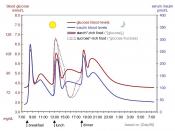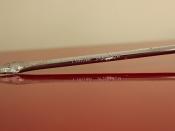Background
After a normal person ingests food, the intricate carbohydrates of the food are broken down to glucose, a simple sugar, which is absorbed into the blood stream. This triggers certain cells in the pancreas to release tiny amounts of insulin, which takes glucose from the blood into each of the cells that make up the body's various tissues and organs. Insulin also helps to burn up the sugar within the cells, releasing the energy required to sustain vital functions. Without insulin, it is extremely difficult for glucose in the blood to be used by the body's cells as energy. Conversely, an abundance of insulin increases the rate at which glucose is used by the cells and therefore lowers the amount of glucose left in the bloodstream.
Early this century, medical scientists found that an insufficiency of insulin, a natural hormone, caused diabetes. Diabetes is one of the most common chronic diseases.
The most abundant form of the disease is Non-Insulin Dependent Diabetes Mellitus (NIDDM), or Type 2 diabetes. This occurs when the body still produces insulin, but either produces insufficient amounts or the insulin that is produced does not function properly. The other form of the disease, Insulin Dependent Diabetes Mellitus (IDDM), or Type 1 diabetes, is rare. This occurs when the pancreatic cells that produce insulin are not present or not functioning.
Introduction
Vanadium is a naturally occurring metallic element found everywhere. It appears as number 23 on the periodic table. Its common names include vanadium, vanadyl sulfate, vanadate, vanadium salts and vanadate compounds. Vanadium can exist in six oxidation states from -1 to +5. Vanadium can also form polymers, which are compounds formed from repeating units. The chemistry of vanadium can be very complicated, but the compounds are striking for their varied colors. In animals and humans,


